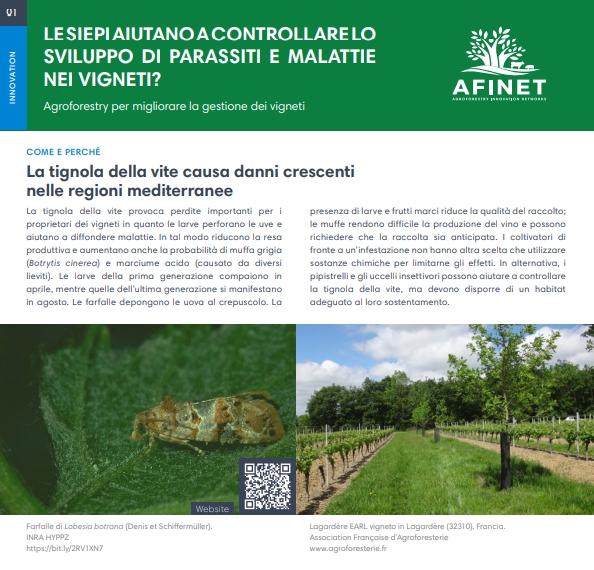 |
01 Le siepi aiutano a controllare lo sviluppo do parassiti e malattie nei vigneti? La tignola della vite provoca perdite importanti per i proprietari dei vigneti in quanto le larve perforano le uve e aiutano a diffondere malattie. In tal modo riducono la resa produttiva e aumentano anche la probabilità di muffa grigia (Botrytis cinerea) e marciume acido (causato da diversi lieviti). |
|
 |
Per molte delle oltre 600.000 aziende forestali in Finlandia, la selvicoltura è una fonte di reddito, tuttavia, il prezzo degli alberi di piccole dimensioni è generalmente basso (circa 2 €/albero). La coltivazione di funghi in foresta può costituire un reddito aggiuntivo aumentando notevolmente i guadagni ottenibili dalle foreste. |
|
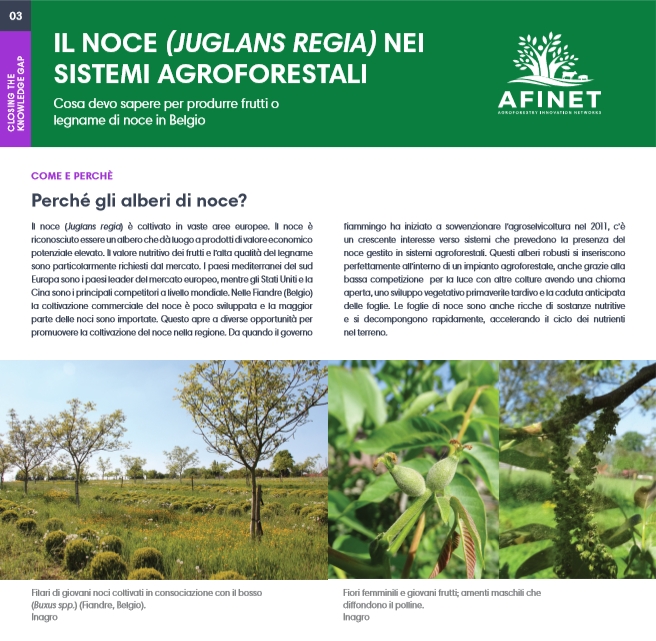 |
03 Il noce ("Juglans regia") nei sistemi agroforestali Il noce ("Juglans regia") è coltivato in vaste aree europee. Il noce è riconosciuto essere un albero che dà luogo a prodotti di valore economico potenziale elevato. Il valore nutritivo dei frutti e l’alta qualità del legname sono particolarmente richiesti dal mercato. I paesi mediterranei del sud Europa sono i paesi leader del mercato europeo, mentre gli Stati Uniti e la Cina sono i principali competitori a livello mondiale. Nelle Fiandre (Belgio) la coltivazione commerciale del noce è poco sviluppata e la maggior parte delle noci sono importate. |
|
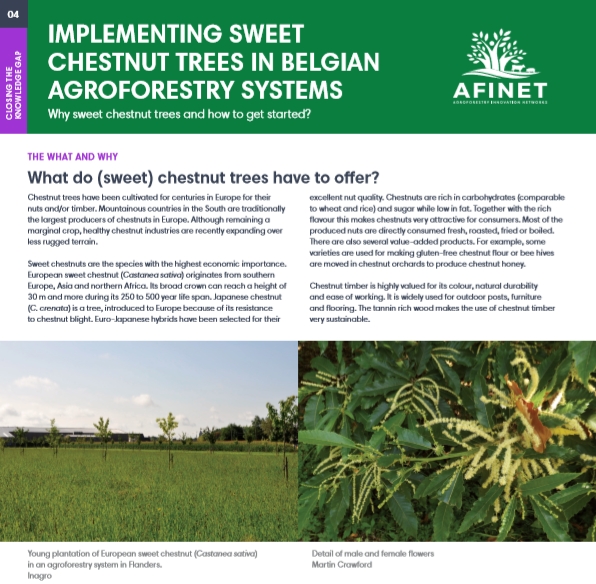 |
04 Implementing sweet chestnut trees in Belgian agroforestry systems Chestnut trees have been cultivated for centuries in Europe for their nuts and/or timber. Mountainous countries in the South are traditionally the largest producers of chestnuts in Europe. Although remaining a marginal crop, healthy chestnut industries are recently expanding over less rugged terrain. Download the high resolution print version (available soon) |
|
 |
05 Raccolta dell'acqua piovana nei sistemi silvopastorali mediterranei In aree aride come quelle della regione mediterranea, la disponibilità di acqua è spesso un fattore limitante che richiede l’adozione di pratiche e strumenti di gestione sostenibile. Queste problematiche sono ancora più rilevanti negli attuali scenari di cambiamento climatico. La pioggia può essere anche causa di erosione del suolo. |
|
 |
06 Shelterbelts and windbreaks: principles for installation Wind can affect crops and animals, by directly or indirectly acting on mechanical or physiological processes related to microclimate and soil. There are several tree elements that, when correctly planed, allow the reduction of these effects. At the landscape level, most of the time they are used in combination with each other to reduce wind damage. Download the high resolution print version (available soon) |
|
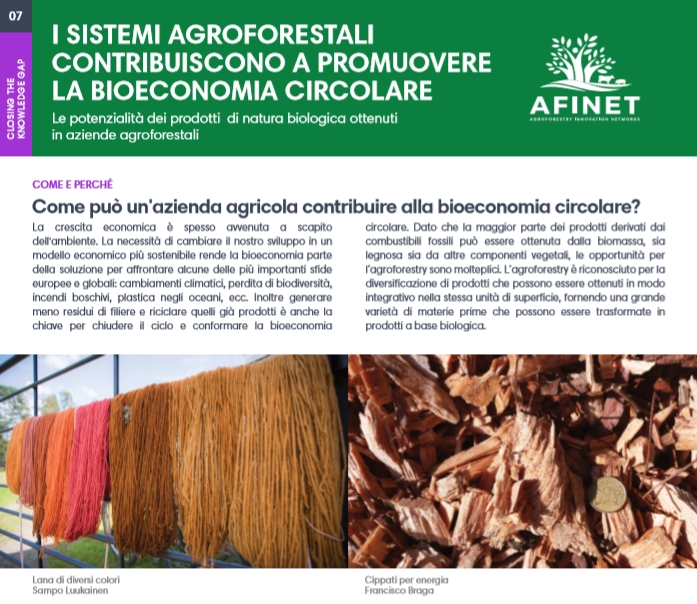 |
07 I sistemi agroforestali contribuiscono a promuovere la bioeconomia circolare La crescita economica è spesso avvenuta a scapito dell'ambiente. La necessità di cambiare il nostro sviluppo in un modello economico più sostenibile rende la bioeconomia parte della soluzione per affrontare alcune delle più importanti sfide europee e globali:cambiamenti climatici, perdita di biodiversità, incendi boschivi, plastica negli oceani, ecc. |
|
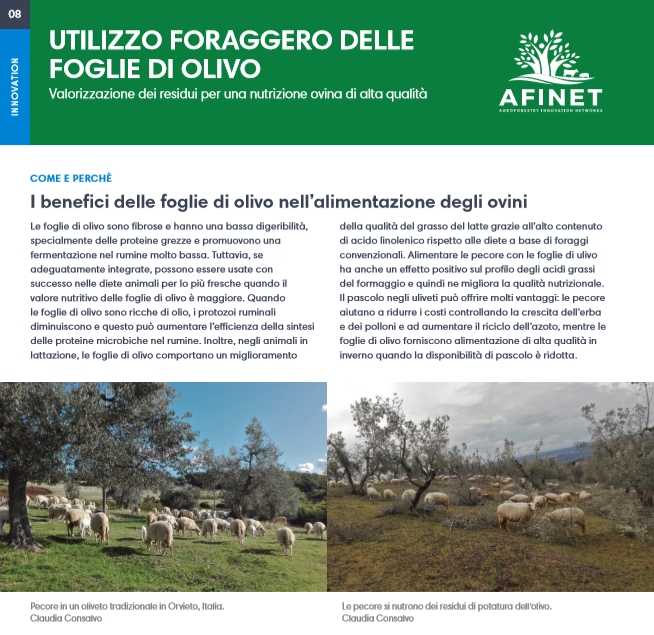 |
08 Utilizzo foraggero delle foglie di olivo Le foglie di olivo sono fibrose e hanno una bassa digeribilità, specialmente delle proteine grezze e promuovono una fermentazione nel rumine molto bassa. Tuttavia, se adeguatamente integrate, possono essere usate con successo nelle diete animali per lo più fresche quando il valore nutritivo delle foglie di olivo è maggiore. |
|
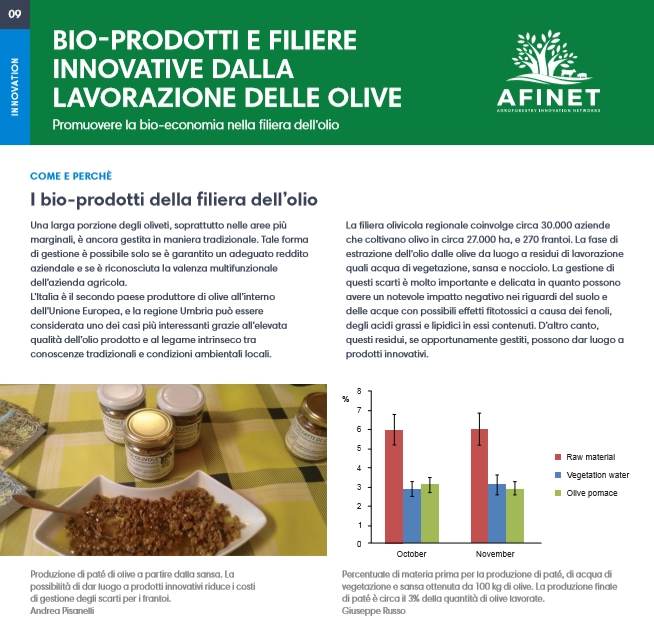 |
09 Bio-prodotti e filiere innovative dalla lavorazione delle olive Una larga porzione degli oliveti, soprattutto nelle aree più marginali, è ancora gestita in maniera tradizionale. Tale forma di gestione è possibile solo se è garantito un adeguato reddito aziendale e se è riconosciuta la valenza multifunzionale dell’azienda agricola. |
|
 |
10 Come gestire lo spazio sotto la copertura degli alberi in un sistema agroforestale In un sistema silvoarabile, c’è una porzione di terreno disponibile sotto la chioma degli alberi (ad esempio la fascia lungo la fila degli alberi) dove non è possibile coltivare le colture agrarie presenti tra le fila. Questa porzione di terreno può svolgere diverse funzioni: i) protegge gli alberi da eventuali danneggiamenti che potrebbero essere causati dai mezzi meccanici; ii) permette l’accesso agli alberi senza danneggiare le colture agrarie consociate tra le fila; iii) fornisce diversi benefici ecologici in quanto può essere l’habitat di altre specie vegetali e animali. |
|
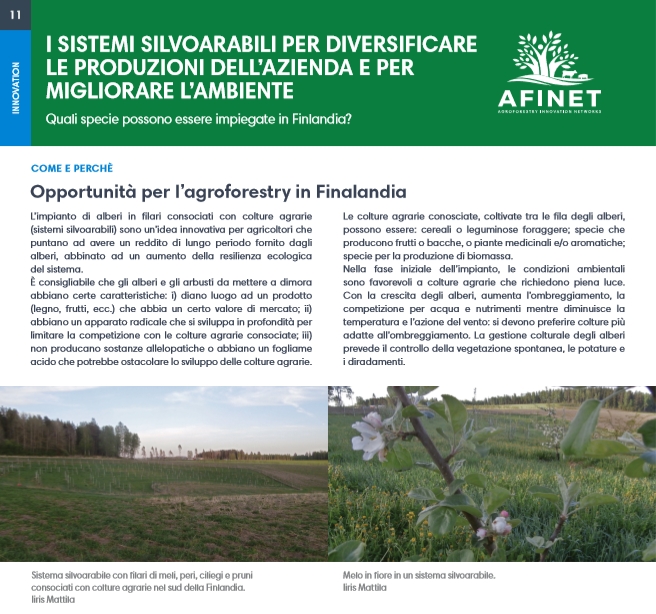 |
11 I sistemi silvoarabili per diversificare le produzioni dell'azienda e per migliorare l'ambiente L’impianto di alberi in filari consociati con colture agrarie (sistemi silvoarabili) sono un’idea innovativa per agricoltori che puntano ad avere un reddito di lungo periodo fornito dagli alberi, abbinato ad un aumento della resilienza ecologica del sistema. |
|
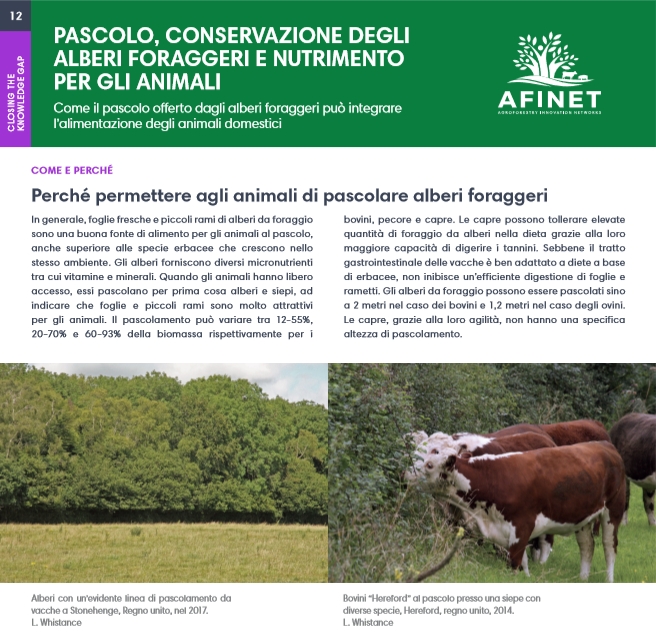 |
12 Pascolo, conservazione degli alberi foraggeri e nutrimento per gli animali In generale, foglie fresche e piccoli rami di alberi da foraggio sono una buona fonte di alimento per gli animali al pascolo, anche superiore alle specie erbacee che crescono nello stesso ambiente. Gli alberi forniscono diversi micronutrienti tra cui vitamine e minerali. |
|
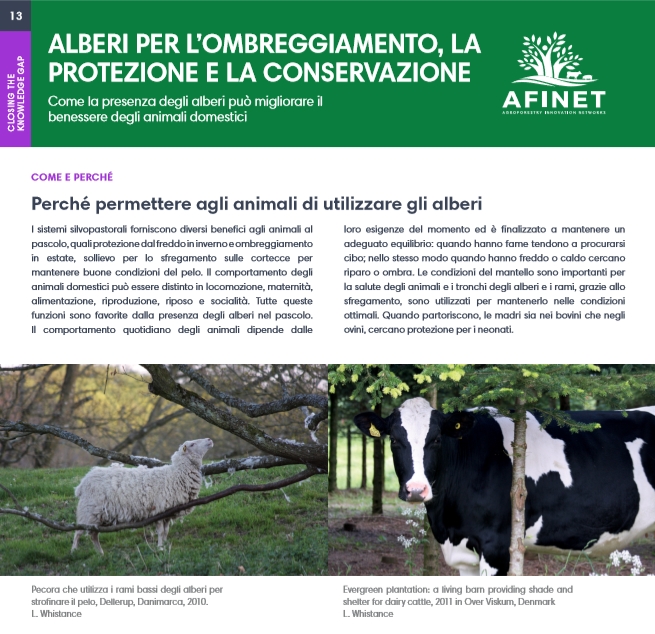 |
13 Alberi per l'ombreggiamento, la protezione e la conservazione I sistemi silvopastorali forniscono diversi benefici agli animali al pascolo, quali protezione dal freddo in inverno e ombreggiamento in estate, sollievo per lo sfregamento sulle cortecce per mantenere buone condizioni del pelo. Il comportamento degli animali domestici può essere distinto in locomozione, maternità, alimentazione, riproduzione, riposo e socialità. |
|
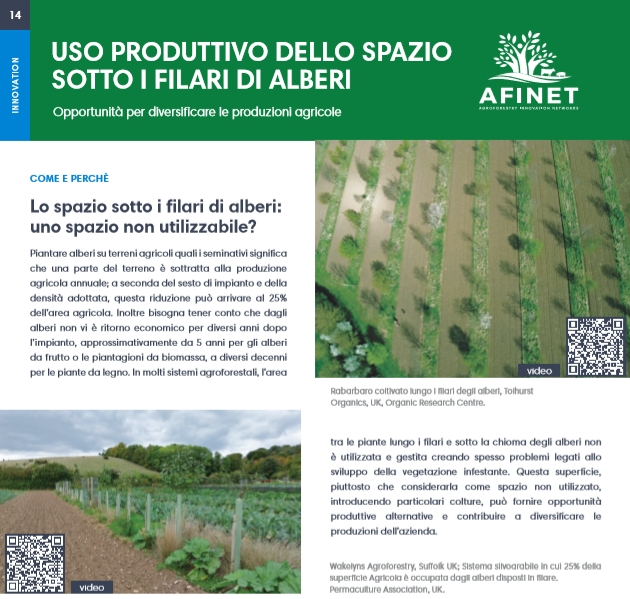 |
14 Uso produttivo dello spazio sotto i filari di alberi Piantare alberi su terreni agricoli quali i seminativi significa che una parte del terreno è sottratta alla produzione agricola annuale; a seconda del sesto di impianto e della densità adottata, questa riduzione può arrivare al 25% dell’area agricola. |
|
 |
15 Agroforestry and agricultural policy definitions Agroforestry has been recognized by international organisms (FAO, UN, EU) as a sustainable land management system, that is not extensively used in temperate areas. One of the main reasons for this fact is the lack of knowledge of agroforestry by different types of stakeholders such as policy makers, farmers and general public. Download the high resolution print version (available soon) |
|
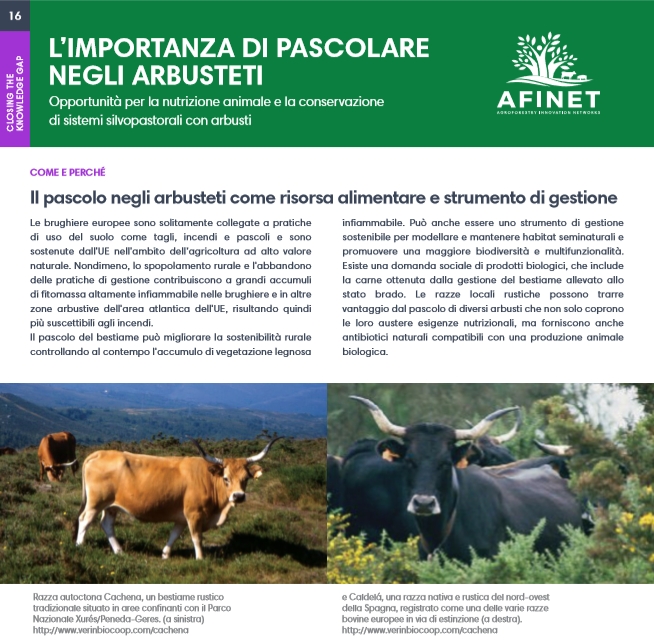 |
16 L'importanza di pascolare negli arbusteti Le brughiere europee sono solitamente collegate a pratiche di uso del suolo come tagli, incendi e pascoli e sono sostenute dall'UE nell'ambito dell’agricoltura ad alto valore naturale. Nondimeno, lo spopolamento rurale e l'abbandono delle pratiche di gestione contribuiscono a grandi accumuli di fitomassa altamente infiammabile nelle brughiere e in altre zone arbustive dell'area atlantica dell'UE, risultando quindi più suscettibili agli incendi. |
|
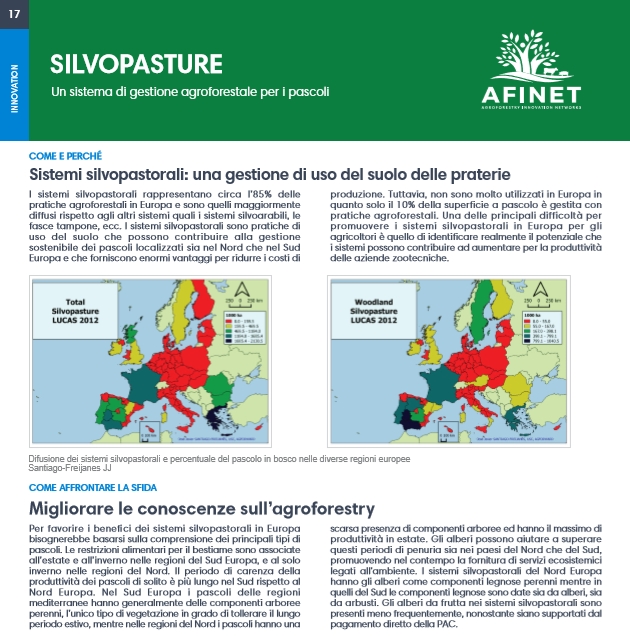 |
I sistemi silvopastorali rappresentano circa l’85% delle pratiche agroforestali in Europa e sono quelli maggiormente diffusi rispetto agli altri sistemi quali i sistemi silvoarabili, le fasce tampone, ecc. I sistemi silvopastorali sono pratiche di uso del suolo che possono contribuire alla gestione sostenibile dei pascoli localizzati sia nel Nord che nel Sud Europa e che forniscono enormi vantaggi per ridurre i costi di produzione. |
|
 |
18 Gestione delle siepi campestri per la produzione di legna da ardere Ross Dickinson, un imprenditore agricolo e produttore di legna da ardere in Dorset (Inghilterra), spiega che "ho cambiato la gestione di una delle mie siepi, dal tagliare ogni anno al la sciarla crescere e ceduarla una volta ogni 15anni per la produzione di legna da ardere. Tenendo conto dei risparmi sui costi di taglio, sono stato in grado di ottenere un buon profitto, suffi ciente per mantenere occupato qualcuno”. |
|
 |
19 Collaborazione per sistemi agroforestali di sucess La maggior parte dei sistemi agroforestali esistenti nelle aziende agricole del Regno Unito sono stati creati dall’agricoltore che è anche il proprietario terriero o l'affittuario. Tuttavia, molti agricoltori non hanno ne il tempo e le conoscenze specifiche per piantare e curare gli alberi, ne il capitale per investire negli alberi, soprattutto quando si crea una nuova impresa agricola. |
|
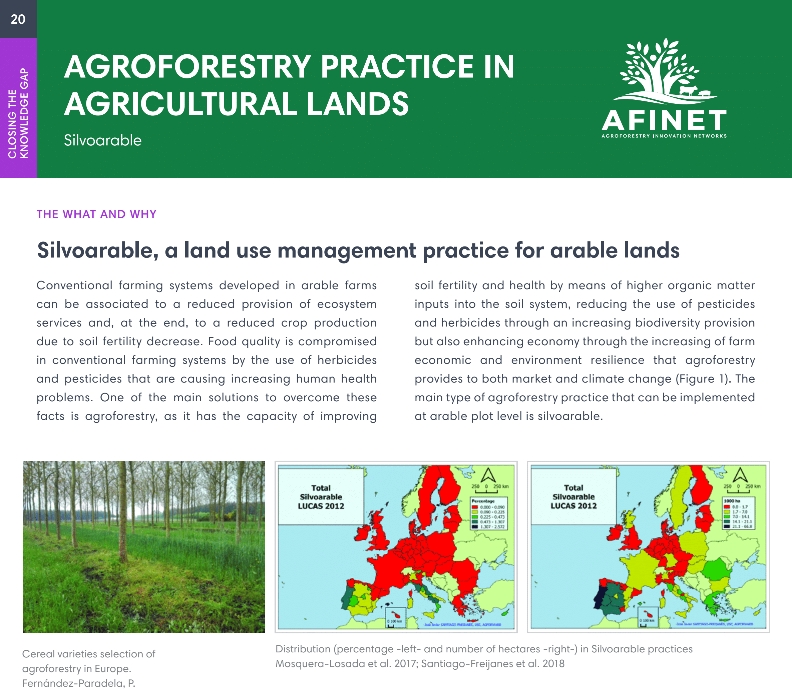 |
20 Agroforestry practice in agricultural lands Conventional farming systems developed in arable farms can be associated to a reduced provision of ecosystem services and, at the end, to a reduced crop production due to soil fertility decrease. Food quality is compromised in conventional farming systems by the use of herbicides and pesticides that are causing increasing human health problems. Download the high resolution print version (available soon) |
|
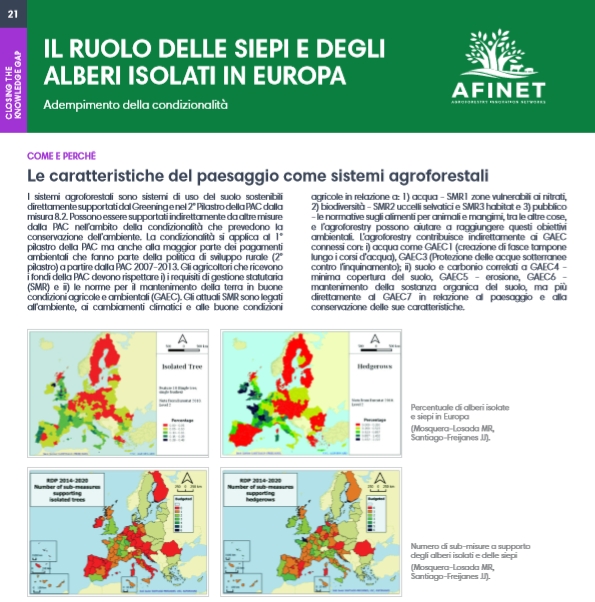 |
21 Il ruolo delle siepi e degli alberi isolati in Europa I sistemi agroforestali sono sistemi di uso del suolo sostenibili direttamente supportati dal Greening e nel 2° Pilastro della PAC dalla misura 8.2. Possono essere supportati indirettamente da altremisure dalla PAC nell’ambito della condizionalità che prevedono la conservazione dell’ambiente. La condizionalità si applica al 1° pilastro della PAC ma anche alla maggior parte dei pagamenti ambientali che fanno parte della politica di sviluppo rurale (2° pilastro) a partire dalla PAC 2007-2013. |
|
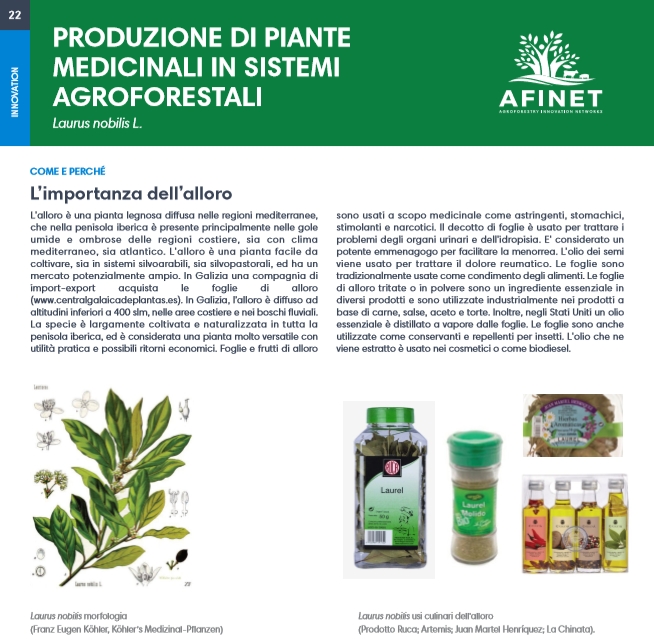 |
22 Produzione di piante medicinali in sistemi agroforestali L'alloro è una pianta legnosa diffusa nelle regioni mediterranee, che nella penisola iberica è presente principalmente nelle gole umide e ombrose delle regioni costiere, sia con clima mediterraneo, sia atlantico. L'alloro è una pianta facile da coltivare, sia in sistemi silvoarabili, sia silvopastorali, ed ha un mercato potenzialmente ampio. |
|
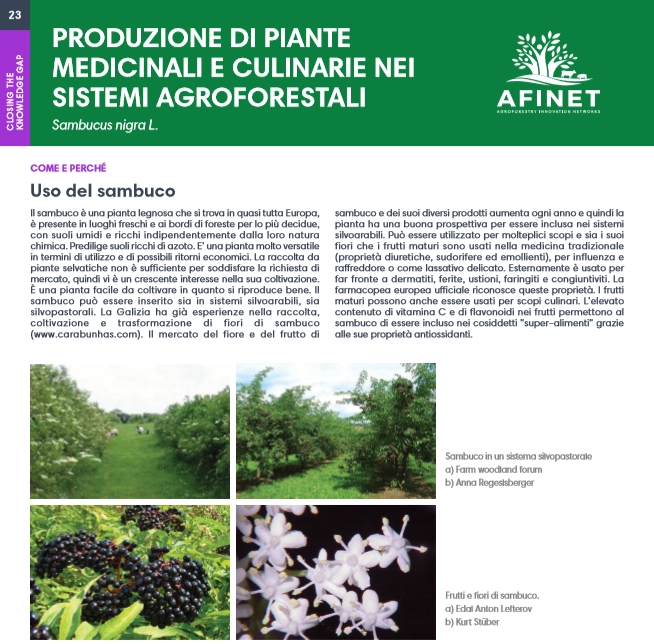 |
23 Produzione di piante medicinali e culinarie nei sistemi agroforestali Il sambuco è una pianta legnosa che si trova in quasi tutta Europa, è presente in luoghi freschi e ai bordi di foreste per lo più decidue, con suoli umidi e ricchi indipendentemente dalla loro natura chimica. Predilige suoli ricchi di azoto. E' una pianta molto versatile in termini di utilizzo e di possibili ritorni economici. |
|
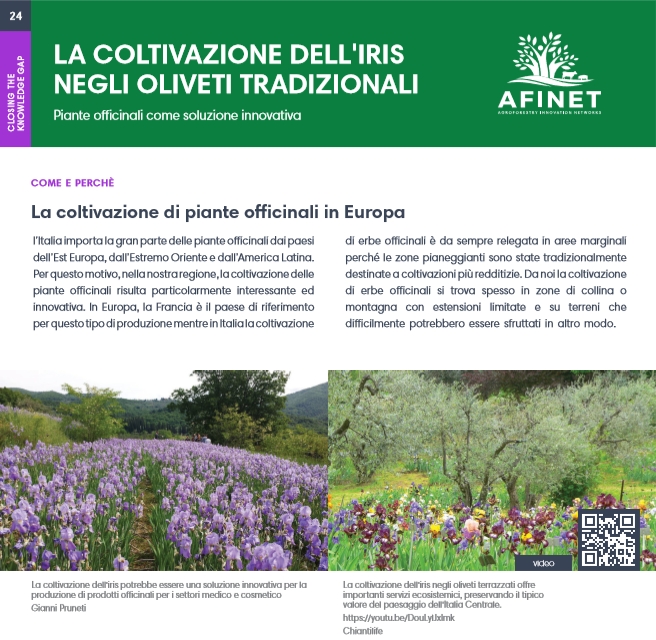 |
24 La coltivazione dell'iris negli oliveti tradizionali l’Italia importa la gran parte delle piante officinali dai paesi dell’Est Europa, dall’Estremo Oriente e dall’America Latina. Per questo motivo, nella nostra regione, la coltivazione delle piante officinali risulta particolarmente interessante ed innovativa. |
|
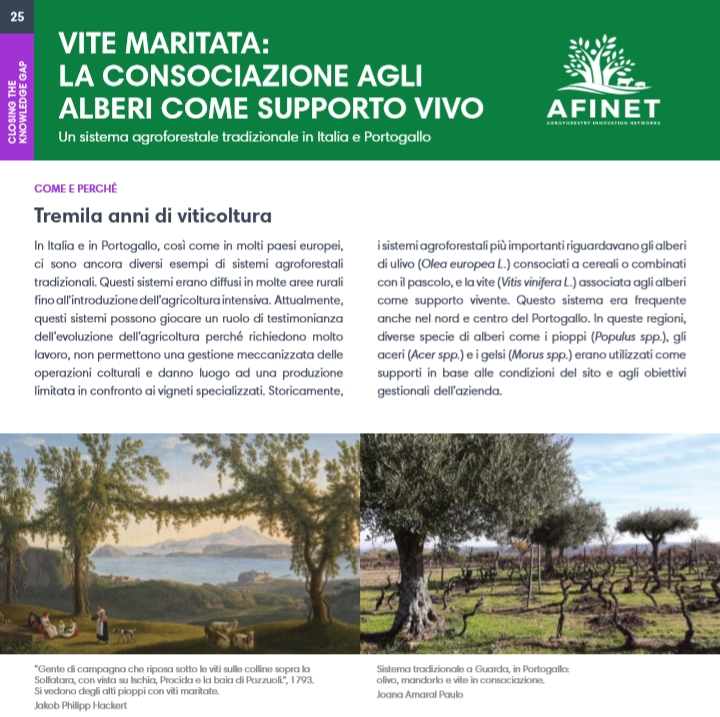 |
25 Vite maritata: la consociazione agli alberi come supporto vivo In Italia e in Portogallo, così come in molti paesi europei, ci sono ancora diversi esempi di sistemi agroforestali tradizionali. Questi sistemi erano diffusi in molte aree rurali fino all'introduzione dell’agricoltura intensiva. |
|
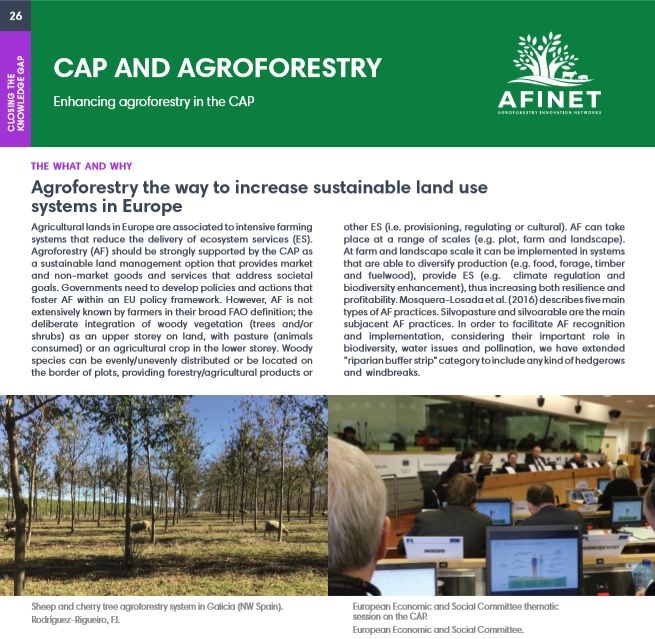 |
Agricultural lands in Europe are associated to intensive farming systems that reduce the delivery of ecosystem services (ES). Agroforestry (AF) should be strongly supported by the CAP as a sustainable land management option that provides market and non-market goods and services that address societal goals. Governments need to develop policies and actions that foster AF within an EU policy framework. Download the high resolution print version (available soon) |
|
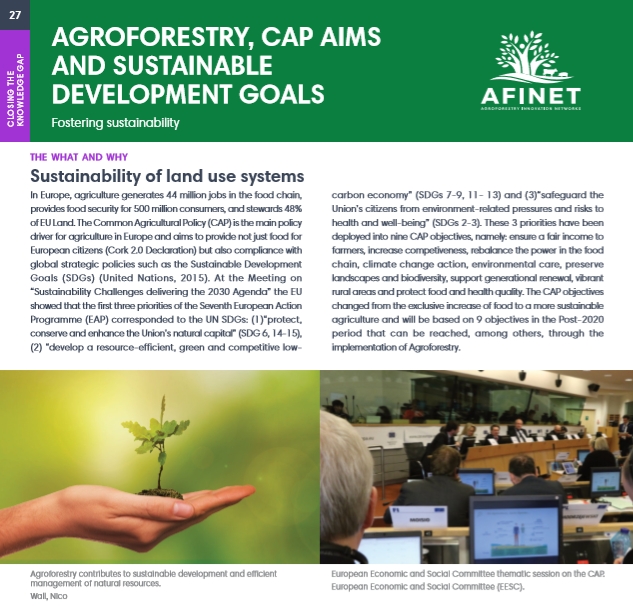 |
27 Agroforestry, CAP aims and sustainable development goals In Europe, agriculture generates 44 million jobs in the food chain, provides food security for 500 million consumers, and stewards 48% of EU Land. The Common Agricultural Policy (CAP) is the main policy driver for agriculture in Europe and aims to provide not just food for European citizens (Cork 2.0 Declaration) but also compliance with global strategic policies such as the Sustainable Development Goals (SDGs) (United Nations, 2015). Download the high resolution print version (available soon) |
|
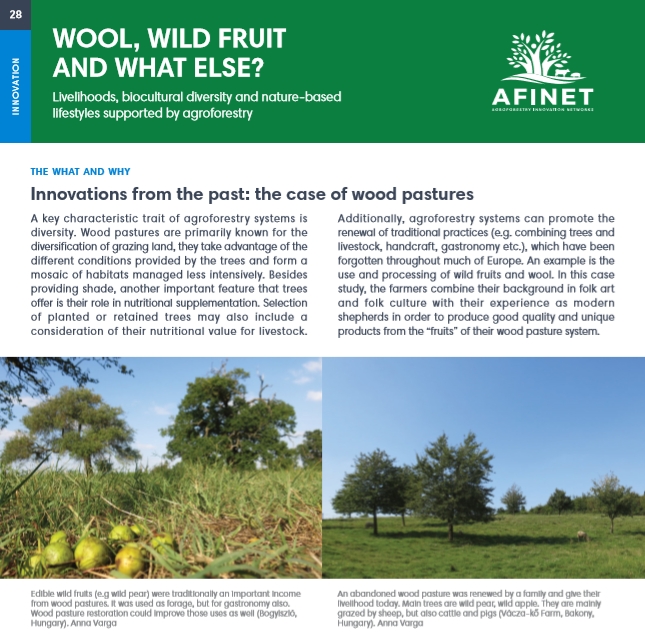 |
28 Wool, wild fruit and what else? A key characteristic trait of agroforestry systems is diversity. Wood pastures are primarily known for the diversification of grazing land, they take advantage of the different conditions provided by the trees and form a mosaic of habitats managed less intensively. Besides providing shade, another important feature that trees offer is their role in nutritional supplementation. |
|
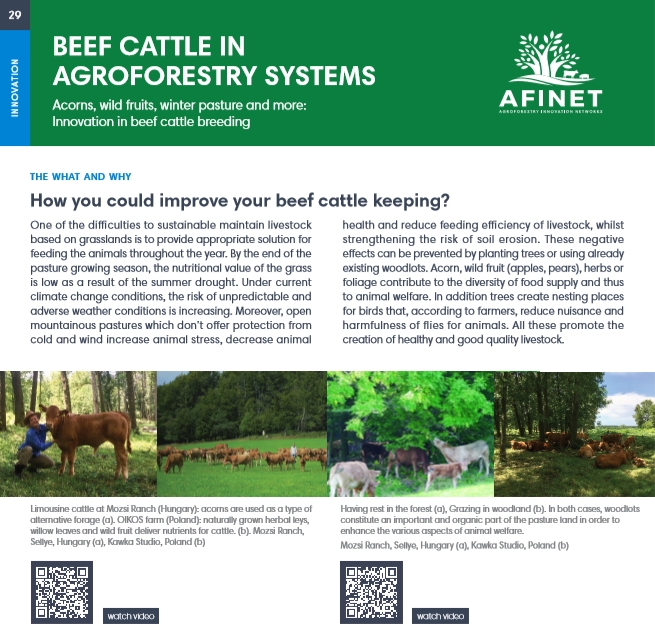 |
29 Beef cattle in agroforestry systems One of the difficulties to sustainable maintain livestock based on grasslands is to provide appropriate solution for feeding the animals throughout the year. By the end of the pasture growing season, the nutritional value of the grass is low as a result of the summer drought. Under current climate change conditions, the risk of unpredictable and adverse weather conditions is increasing. |
|
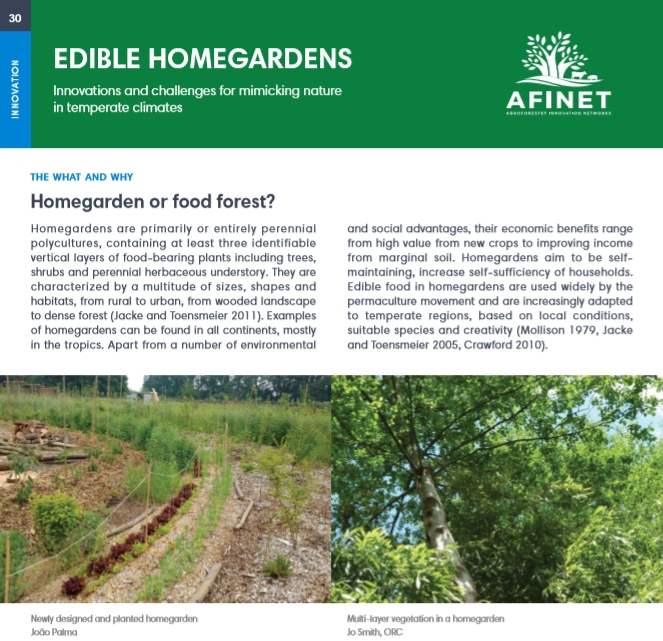 |
Homegardens are primarily or entirely perennial polycultures, containing at least three identifiable vertical layers of food-bearing plants including trees, shrubs and perennial herbaceous understory. They are characterized by a multitude of sizes, shapes and habitats, from rural to urban, from wooded landscape to dense forest (Jacke and Toensmeier 2011). Download the high resolution print version (available soon) |
|
 |
For centuries, in Northwestern Europe, the production of fruit has been integrated in agroforestry practices. Several traditional systems were widespread over Europe whereby fruit trees were combined with cattle (e.g. “pré-vergers”) or with arable cropping (e.g. “streuobstäcker”). Download the high resolution print version (available soon) |
|
 |
32 Rotational cattle grazing in traditional orchards Traditional orchards are valuable elements of rural landscapes and sources of income for smallholders., almost 3000 local apples varieties still exist in Central Europe alone. They are naturally resistant to frost, diseases, pests and each provides a unique taste and healthy values. Value-added income can be improved by integrating livestock grazing activities. Download the high resolution print version (available soon) |
|
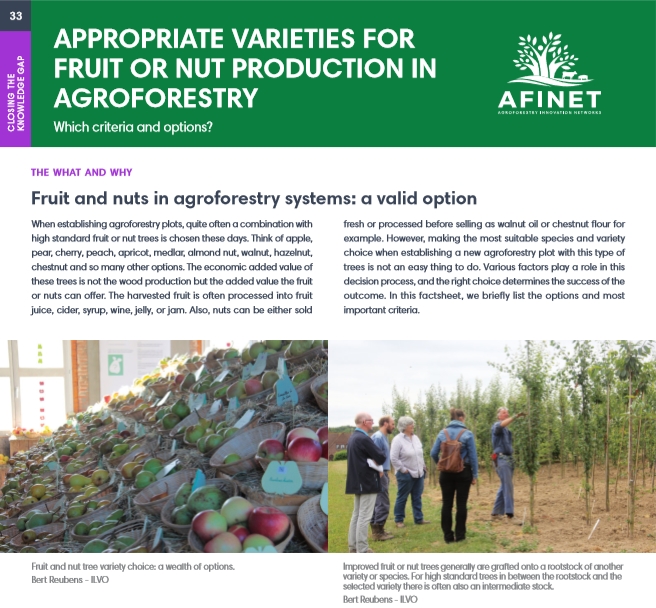 |
33 Appropriate varieties for fruit or nut production in agroforestry When establishing agroforestry plots, quite often a combination with high standard fruit or nut trees is chosen these days. Think of apple, pear, cherry, peach, apricot, medlar, almond nut, walnut, hazelnut, chestnut and so many other options. The economic added value of these trees is not the wood production but the added value the fruit or nuts can offer. Download the high resolution print version (available soon) |
|
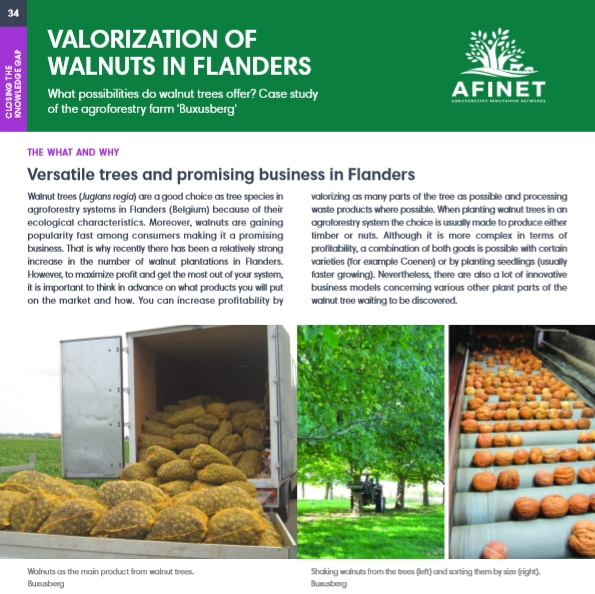 |
34 Valorization of walnuts in Flanders Walnut trees (Juglans regia) are a good choice as tree species in agroforestry systems in Flanders (Belgium) because of their ecological characteristics. Moreover, walnuts are gaining popularity fast among consumers making it a promising business. That is why recently there has been a relatively strong increase in the number of walnut plantations in Flanders. Download the high resolution print version (available soon) |
|
 |
35 Use of fast growing tree species in a crop rotation In a medium or poor-yieldingcorn-growing area, short rotation tree plantations can be incorporated into a crop rotation in order to improve the soil conditions and to increase the production of the system. One possibility for such agroforestry systems is to plant trees for biomass at high planting density. |
|
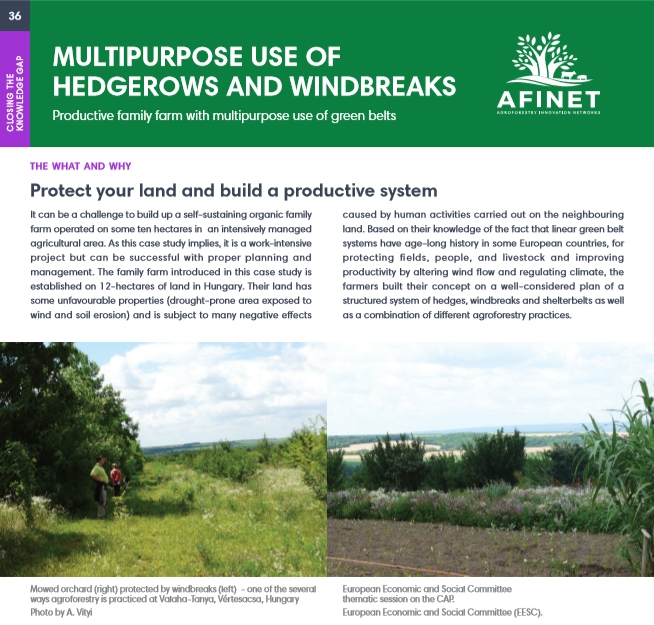 |
36 Multipurpose use of hedgerows and windbreaks It can be a challenge to build up a self-sustaining organic family farm operated on some ten hectares in an intensively managed agricultural area. As this case study implies, it is a work-intensive project but can be successful with proper planning and management. The family farm introduced in this case study is established on 12-hectares of land in Hungary. Download the high resolution print version (available soon) |
|
 |
37 Post fire management of cork oak forest (Quercus suber) It can be a challenge to build up a self-sustaining organic family farm operated on some ten hectares in an intensively managed agricultural area. As this case study implies, it is a work-intensive project but can be successful with proper planning and management. The family farm introduced in this case study is established on 12-hectares of land in Hungary. Download the high resolution print version (available soon) |
|
 |
38 Designing a profitable agroforestry system with poplar and wheat Today, the decrease in new poplar planting is a very worrying factor for the industry. Over the past twenty years, the rate of poplar replanting in France has decreased from 2.3 million plants per year in the early 1990s to less than 600 000 plants per year in 2013. Today in France, more than one in three parcels is not reforested. This has become very insufficient to ensure the future supply of processing industries. |
|
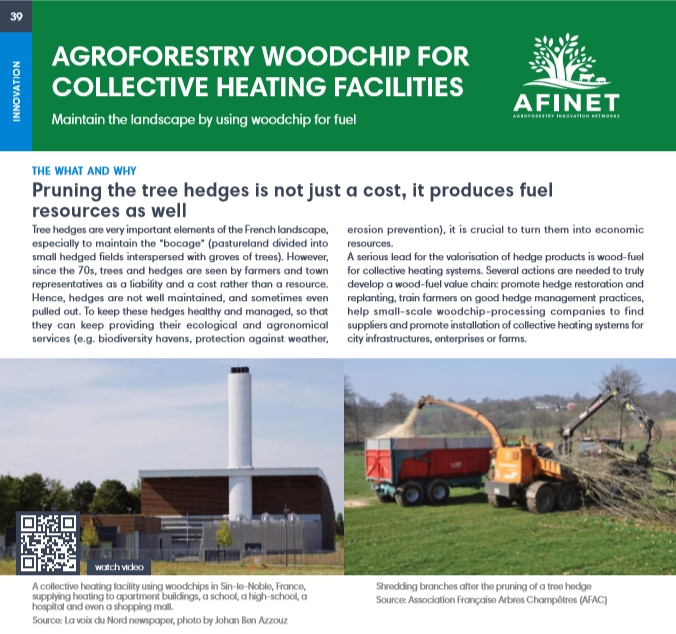 |
39 Agroforestry woodchip for collective heating facilities Tree hedges are very important elements of the French landscape, especially to maintain the “bocage” (pastureland divided into small hedged fields interspersed with groves of trees). However, since the 70s, trees and hedges are seen by farmers and town representatives as a liability and a cost rather than a resource. |
|
 |
Knowledge transfer is one of the key axes for the development of innovative practices such as agroforestry. Agronomy, ecology, tree management, etc. are already particularly complex fields of expertise when undertaken separately, so composite subjects such as agroecology or agroforestry require an even deeper understanding of interdependent varying factors and interactions between components at the system level. |
|
 |
41 "Trees in the field" as a selling argument Agroforestry, being still a marginal form of farming now in France, is not yet well-known by the consumers. However, we now know that this way of producing food, combined with a global agroecological approach, leads to more sustainable systems. Agroforestry goes beyond simple food production, providing ecological and social services. |
|
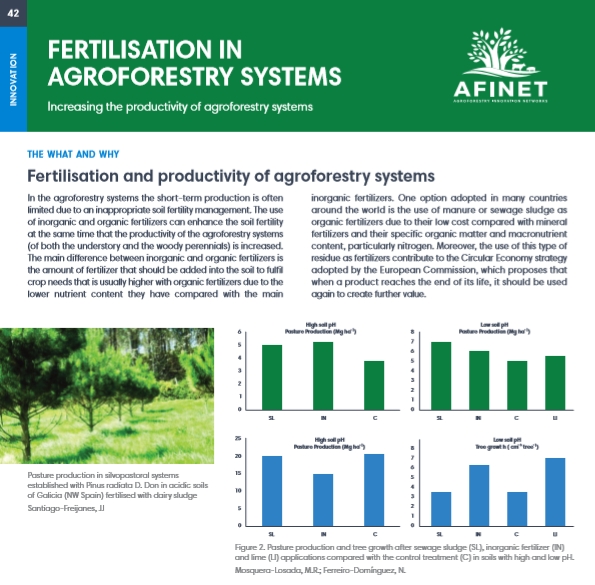 |
42 Fertilisation in agroforestry systems In the agroforestry systems the short-term production is often limited due to an inappropriate soil fertility management. The use of inorganic and organic fertilizers can enhance the soil fertility at the same time that the productivity of the agroforestry systems (of both the understory and the woody perennials) is increased. Download the high resolution print version (available soon) |
|
 |
43 Shade tolerant grasses and legumes Silvopastoral systems are designed to simultaneously produce timber/fruit/wood biomass in the long term and high-quality forage resources and efficient livestock production thus ensuring short-term and continuous cash flow. Download the high resolution print version (available soon) |
|
 |
44 “Pastores de Galicia”, guarantee of an artisan breeding way The “Pastores de Galicia” brand was created by the Association of Sheep and Goats Breeders of Galicia in 2015. Its objective is to distinguish in the market the lamb and goat meat produced in Galicia and associated with the use of natural resources by grazing mothers and feeding lambs and kids based on breast milk directly from the udder and cereals. Download the high resolution print version (available soon) |
|
 |
45 Using local breeds to add-value to meat products The use of local breeds fed with local woody perennial resources by using silvopastoralism produce a high-quality meat product with more added value than meat coming from intensive industrial production systems. Moreover, silvopastoralism is based on resources that are only used by these local adapted breed grazers. The calf diet is based on 90% breast milk, since they are breast-fed calves, whose mothers feed on woody perennials.
Download the high resolution print version (available soon) |











